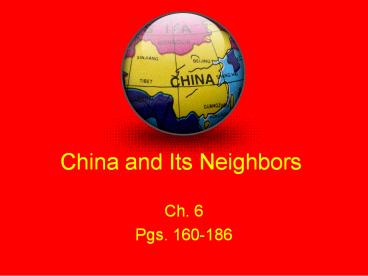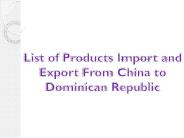China and Its Neighbors - PowerPoint PPT Presentation
1 / 76
Title:
China and Its Neighbors
Description:
China and Its Neighbors Ch. 6 Pgs. 160-186 Taiwan s People Population 22.5 million 75% of people live in cities Taipei the capital city is the most populous city ... – PowerPoint PPT presentation
Number of Views:295
Avg rating:3.0/5.0
Title: China and Its Neighbors
1
China and Its Neighbors
- Ch. 6
- Pgs. 160-186
2
Section 1
- Land and Economy
3
(No Transcript)
4
China
- Officially called the Peoples Republic of China
- 3rd largest country in terms of lands size
- Slightly larger than the U.S.
5
Land and Climate
- Mountains cover 1/3rd of the country
- Himalaya, Kunlun Shan, Tian Shan, and Altay
- Plateau of Tibet
- Called the roof of the world
- Worlds largest plateau
- Turpan depression 505ft below sea level
- Filled with salt lakes
- Hottest area of China
6
(No Transcript)
7
Land and Climate cont.
- Gobi desert
- Desert made of rocks and stones
- Fertile plains
- On the eastern and southern coasts
- Most people in China live here
8
(No Transcript)
9
Rivers
- Yangtze, Yellow, Xi
- Serve as important transportation routes
- Source of soil from floods
10
(No Transcript)
11
Yellow river
- Called Chinas sorrow
- Floods have killed thousands and caused much
damage - Built dams and dikes (high banks of soil) to
control the flooding
12
3 Gorges Dam
- Built across the Yangtze River
- Helps
- control flooding
- Allow large ships to travel inland (reduce trade
costs) - Hydro electric power
- Problems
- Reservoir will flood more than 100 towns
- 1.2 million people will be forced to move
- Wash away 1,000 historical sites
- Underwater industrial sites could leak hazardous
wastes - Pollutants from towns could leak into the
reservoir
13
(No Transcript)
14
Unsteady Land
- Ring of Fire
- Pacific Coastal areas with volcanoes and frequent
earthquakes - Eastern China lies on a fault or crack in the
earths crust - Causes many earthquakes
15
Communist State
- Communist since 1949
- Government has strong control over the economy
and society - Government officials decide what crops are grown,
what products are made, and what prices are
charged
16
A New Economy
- China discovered that communism had many problems
- Behind in technology
- Manufactured goods were poor in quality
- Leaders have taken steps to make the economy
stronger - Allowed some free enterprise systems
- Government allows individuals to choose jobs,
start their own businesses, grow crops they want,
and keep profits they make. - Result, Chinas economy has boomed
17
Foreign Trade
- China asks other countries to invest or put money
into businesses - Many companies are owned by both Chinese and
foreign investors - Benefits
- Pay Chinese workers less
- Large population millions of possible customers
18
Results of Growth
- More people in China are able to get a job in
manufacturing and service industries - Wages have increased
- Better standard of living
- Can afford some consumer goods
- TV
- Car
- Motorcycle
19
Problems with Growth
- Not everyone has adjusted to the new economy
- Prices are rising faster than incomes
- Has hurt the environment
- Factories dump chemicals into the rivers
- Burning coal causes air pollution
- Leads to lung disease (1 cause of death in China)
20
Hong Kong and Macau
- Important cities to Chinas economic changes
- Both controlled by European countries
- Hong Kong Great Britain until 1997
- Macau Portugal until 1999
- One country, Two country system
- Promise to allow western freedoms and capitalism
to exist side by side with Chinese communism
21
Section 2
- Chinas people and culture
22
Overview
- Chinas population 1.27 billion
- 1/5 of the worlds population
- 92 belong to the Han Chinese ethnic group
- 8 belong to 55 other ethnic groups mostly in
western China - Struggle to protect their traditions from the Han
Chinese
23
(No Transcript)
24
Chinas History
- 4,000 year old civilization
- Until the early 1900s emperors and empresses
ruled China - Dynasty line of rulers from a single family
- Would hold power until overthrown and a new
dynasty would begin - Under the dynasties China built a highly
developed civilization
25
(No Transcript)
26
Great Wall
- Chinese tried to keep foreign invaders out
- Most borders are natural barriers
- Deserts, seas and mountains
- To defend northern border the Great Wall was
started 2,200 years ago - Over the centuries the wall was lengthened and
rebuilt - It would eventually stretch 4,000 miles
27
(No Transcript)
28
Culture
- Confucius or Kongfuzi (500 B.C.)
- Chinese thinker
- Be polite, honest, brave, and wise
- Children should obey parents
- Respect elderly
- Obey countries rulers
29
(No Transcript)
30
Culture cont.
- Laozi
- Created Daoism
- People should live simply and in harmony with
nature - Buddhism
- Came to China from Central Asia (100 A.D.)
- Prayer, right thoughts, and good deeds can help
relieve people from lifes problems - China now has a mixture of Confucius, Daoism, and
Buddhism
31
(No Transcript)
32
(No Transcript)
33
Inventions
- Paper
- Silk
- Magnetic Compass
- Printing Press
- Gun Powder
- Fireworks
34
(No Transcript)
35
(No Transcript)
36
(No Transcript)
37
Communist China
- During 1700s and 1800s foreign countries used
military power to force China to trade - Wanted tea, silks, and pottery
- Great Britain and other European countries
38
Communist China cont.
- 1911 Chinese began to feel that the emperor was
too weak - Uprising occurred led by western educated Dr. Sun
Yat-sen - Emperor was overthrown and China became a
republic with elected leaders
39
Communist China cont.
- Disorder followed
- Fighting broke out after WWII between
Nationalists and Communists - Nationalists led by Chiang Kai-shek
- Communists led by Mao Zedong
- 1949 Communists won and created the Peoples
Republic of China - Nationalists fled to the island of Taiwan and set
up their own government there.
40
(No Transcript)
41
Chinas Government
- In 1949 Communists completely changed the
mainland of China - All land and factories were now owned by the
government - Dams and agricultural improvements brought some
economic benefits - Many individual freedoms were lost
- Many were killed for opposing Communism
42
Chinas Government cont.
- Mao died in 1976
- Deng Xiaoping was successor to Mao
- Allowed people to have more economic freedoms
- Government still denied many economic freedoms
and would act harshly against any opposition - In 1989 in Tiananmen Square thousands of students
protested the government calling for democracy.
The government responded with a military force
that killed hundreds and arrested thousands
43
(No Transcript)
44
(No Transcript)
45
(No Transcript)
46
Chinas Government cont.
- Countries around the world have protested Chinas
treatment of its people - Pushes for human rights and basic freedoms
- Some countries even threaten to refuse to trade
with the Chinese
47
Tibet
- Tibet was once a separate Buddhist kingdom until
China took control in the 1950 - People of Tibet have demanded independence
- The Dalai Lama (Buddhist leader of Tibet) was
exiled to India - Exile- when a person is unable to live in their
own country due to their political beliefs
48
(No Transcript)
49
Rural Life
- 64 of Chinas people live in rural areas
- Often use hand tools
- Life in villages is improving
50
Urban life
- More than 460 million people live in cities
- People are leaving farms and going to the cities
in hopes of finding better pay - Very crowded
- Most homes have heat, electricity, and water
- More leisure time to do recreational activities
51
(No Transcript)
52
(No Transcript)
53
(No Transcript)
54
(No Transcript)
55
(No Transcript)
56
Chinas Culture
- Famous for its traditional arts
- Painting
- Sculpture
- Architecture
- Calligraphy- beautiful writing
- There are more than 50,000 characters in the
Chinese language - Average person knows only around 5,000
57
Chinas Culture
- Porcelain is made from coal dust and white clay
- Pagodas- Many storied Buddhist towers
58
Food
- Foods differ from region to region
- Typical meal includes vegetables with meat or
fish and rice or noodles - Soup often used as well
59
Section 3
- Chinas Neighbors
60
(No Transcript)
61
(No Transcript)
62
Taiwan
- Has one of the worlds most prosperous economies
- High technology industries- computers
- Agriculture
- Rice
- Sugarcane
- Citrus fruits
- Tea
- soybeans
63
(No Transcript)
64
Taiwans history
- Part of China for centuries
- 1895 Japan took the island over
- Developed economy but harsh to people
- Returned to China after Japan was defeated in
WWII - 1949 Chinese Nationalists and 1.5 million
refugees came to Taiwan to escape Communist rule - Still calls itself a Chinese country and a
Chinese province - Some would like to see it become independent
65
(No Transcript)
66
Taiwans People
- Population 22.5 million
- 75 of people live in cities
- Taipei the capital city is the most populous city
with 2.6 million
67
(No Transcript)
68
Mongolia
- Landlocked country
- Much of the country is covered by steppes
- Dry treeless plains at the edge of deserts
- Land of extremes
- Very little rain fall
- Dust storms
- Hot summers
- Freezing winters
69
(No Transcript)
70
Mongolias people
- People were nomads for centuries
- Tend sheep, goats, cattle, or camels
- Famous for horse riding skills
- 85 of the people are Mongols
- Speak Mongol
- 60 live in urban areas
- Ulaanbaatar capital and most populous city
71
(No Transcript)
72
(No Transcript)
73
(No Transcript)
74
History
- Known as fierce fighters in the past
- 1200 Genghis Khan led the mongol armies in a
series of war to create the largest empire in
history - Stretched from China all the way to eastern
Europe - 1300s empire weakened and fell apart
- 1924 Mongolia gained its independence from China
- Created a Communist satellite of the USSR
- Became a democracy in 1990
75
(No Transcript)
76
(No Transcript)
77
(No Transcript)
78
Culture
- Some still live a nomadic life style
- Live in yurts
- Large round tents made from animal skin
- Favorite meal is boiled sheeps meat with rice and
tea - Naadam Festival
- Biggest event of the year
- Consists of events such as archery, horse racing,
and wrestling - Buddhism is the major religion
79
(No Transcript)
80
(No Transcript)































